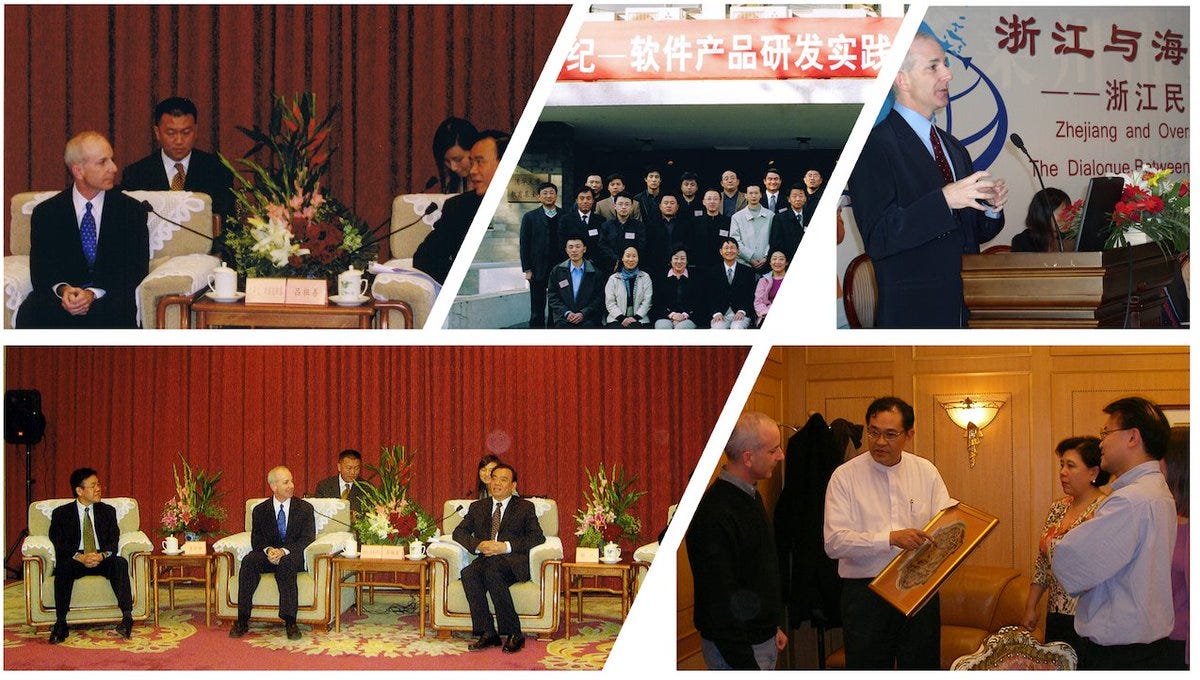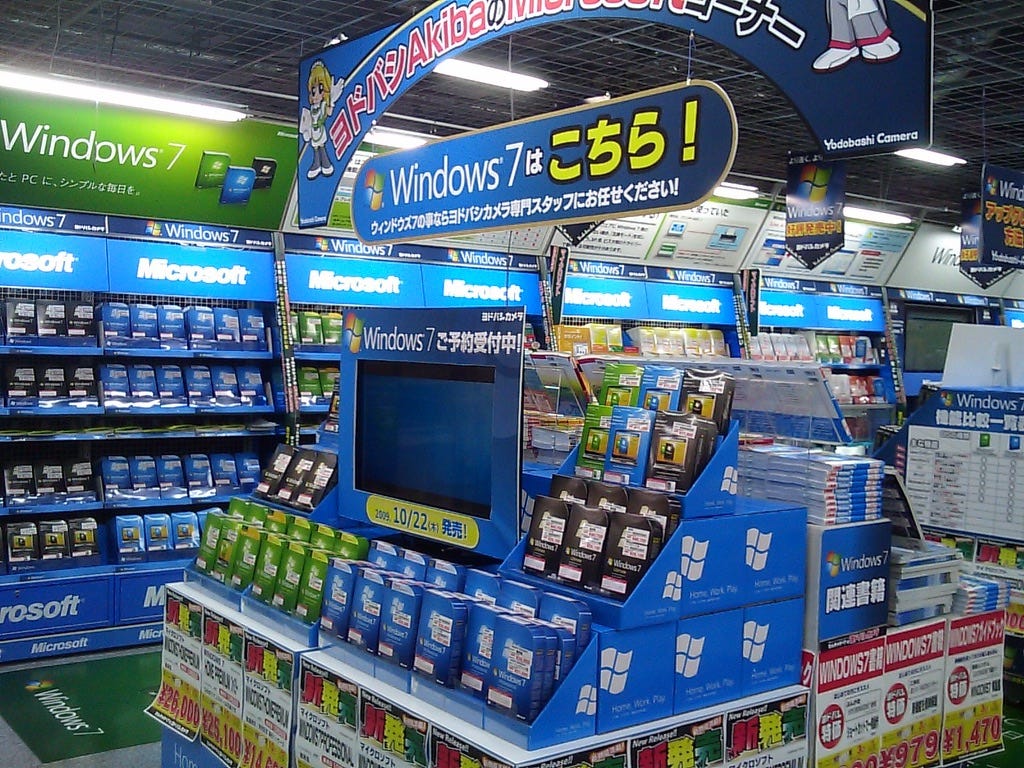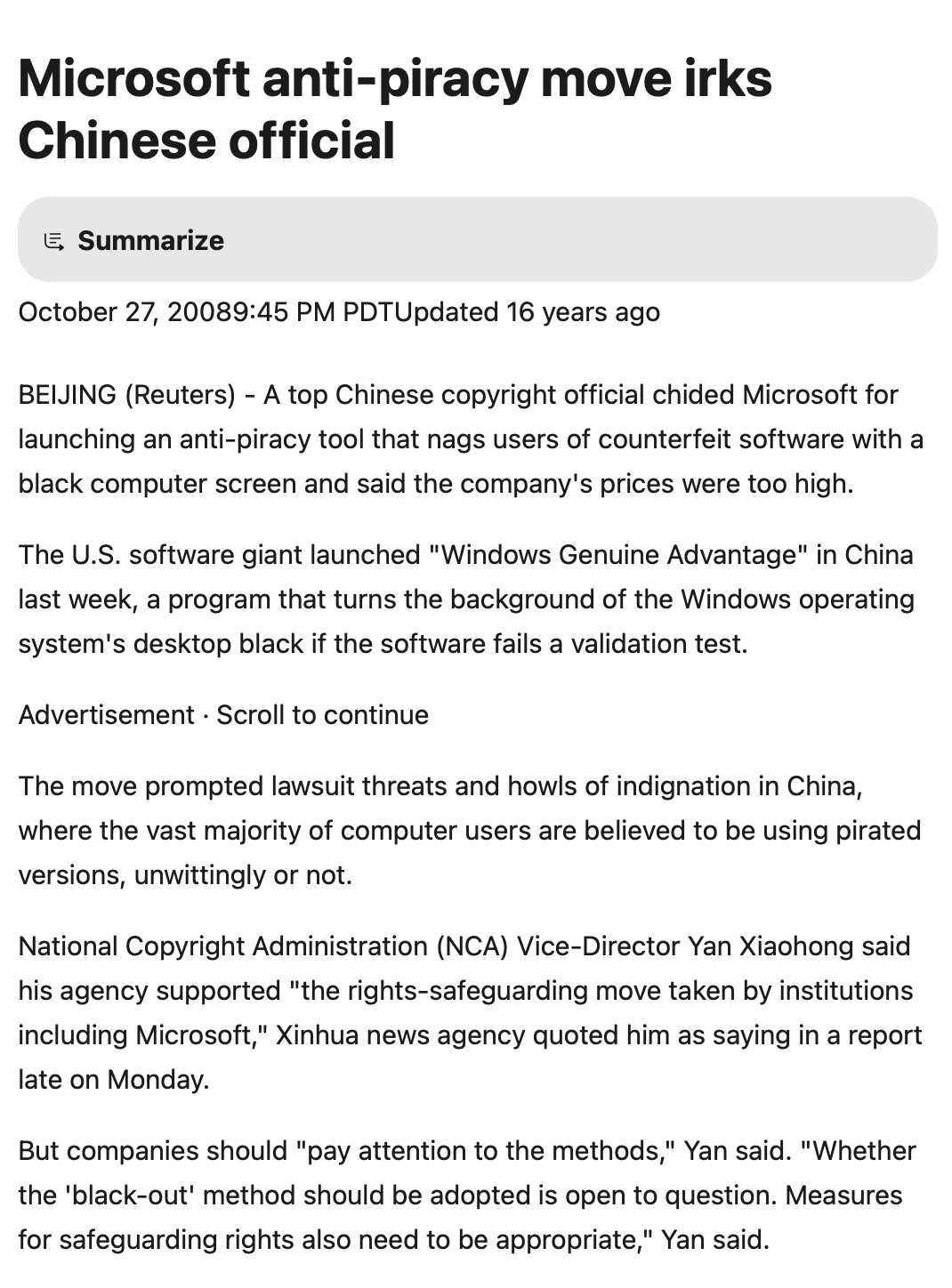231. When It Comes to Tariffs, China is Different
Much has been made of tariffs, but few have talked about the myriad of soft costs when it comes to international trade. Sharing my personal experience of Microsoft and the China market.
Much has been said about how the U.S. benefits from China’s manufacturing strengths, and tariffs often dominate the debate around international trade. But what’s often overlooked is how incredibly difficult it is for American companies to sell into China and to build a sustainable business—particularly when it comes to services and intellectual property. Tariffs are just the visible tip of the iceberg. Beneath the surface lies a vast, complex web of soft barriers, regulations, and cultural dynamics that make the market nearly impossible to access in a fair, sustainable way.
I spent 15 years at Microsoft navigating these waters, including time living and working in China specifically to work on building a real business there. What I experienced was far more challenging—and revealing—than any tariff dispute.

Microsoft’s first foray into Asia was Japan in the late 1980s. It wasn’t easy. There were technical hurdles like no UNICODE yet, a strong local preference for domestic products, and government policies that subtly (and not-so-subtly) favored Japanese companies. In many ways, it was not unlike the “Buy American” policies we see in the U.S. Still, with persistence, respect for local norms, and significant investment in product localization, we found success. Japan’s deep-rooted respect for intellectual property played a key role in that. By the mid-1990s the Office business in Japan was our most profitable in the world and customers—business and consumer—loved the product and how we tailored the distribution and software to the market.
China, however, was an entirely different story.
From the outset, we encountered a maze of complications. An early version of Windows was banned entirely because some of the localization work had been done in Taiwan (see https://www.hbs.edu/faculty/Pages/item.aspx?num=23685). That was just the beginning. We responded with what we believed was good faith effort after good faith effort: We built a significant local development team, pioneered tools like the Input Method Editor that became a much-loved standard, established advanced R&D facilities, and adhered to every guideline for doing business in China—even hiring locals to represent the CCP inside our own offices.
And still, we hit wall after wall.
Piracy was the most obvious and frustrating challenge. While software piracy was a global problem, the scale in China was staggering. Roughly 90% of Microsoft products in use were pirated. Imagine a country with 200 million PCs generating as much revenue as Italy, which had just a quarter of the PCs and a piracy rate of “only” 50%. We used to justify this to ourselves by believing that someday those customers who loved the product for free would come to value it and with support of the government honoring IP would pay us. HA.
Visiting the bustling computer malls made the issue even more concrete. Five or more floors of computers—fully built to build your own. You’d select a system and then they would even assemble it. When you were finished, they gave you a menu to select your software and after a short wait they’d return with a customized CD with any software suite you wanted—Windows, Office, Photoshop—all bundled with serial numbers in a text file in the root and even some pirated movies thrown in for good measure. All for ¥100, the then equivalent of $12.
We pleaded our case in meeting after meeting with government officials. Over long banquets and countless toasts of Baijiu, we would talk about cooperation, innovation, and the value of intellectual property. The response was consistent: the government cited poverty, claiming it couldn't afford licensed software while simultaneously driving black Mercedes and dining in luxury above high-end Ferrari dealerships.
Eventually, some officials were more candid: “We do not believe in your same concept of intellectual property,” they’d tell us. “We believe knowledge should be spread and shared.” In theory, that’s a noble idea—one echoed by open source advocates—but in practice, it was a rationalization for copying and reselling our work without compensation.

With Windows (and then Office) we introduced progressively stronger “anti-piracy” measures only to find customers then just sticking with older versions of software that were easier to pirate, versions that were also far more prone to security exploits. We were showing the government the designs and programs before we released then and yet still suffered from a strong campaign by the government against what we did. We were told our “methods” were not compatible with the market—a simple registration wizard. So, then you could go to the airport and see the warning of “unregistered Windows” pop up over the flight boards. The cash registers at my supermarket ran Windows XP a decade after it had been released rather than pay for Windows. PC makers came to ship PCs without Windows, overtly claiming it was because of US antitrust law they were respecting.
After posting a follower made this comment:
This joint venture suggestion was commonplace. The idea was to establish a shell company that “operated” the Microsoft assets and returned profit to Microsoft. It was touted as a “win-win” approach, which many many companies established for their efforts. A big part of China owning 49% was they would secure all IP rights as well as operational rights to what was going on in the company. In return a company was promised streamlining access to licensing to operate. In the case of the old MSN.COM that actually meant it was the only way to obtain a business license for an internet service, so we never actually closed a JV and ended up with no business. They had other requirements such as the servers all had to reside in China and be open to real-time inspection by the government agency (the Great Firewall). This JV solution was often the only hope of operating in the country and was clearly another form of tariff or even theft.
And it wasn’t just software. American and European companies across industries—pharma, fashion, publishing, autos—faced similar issues. I remember touring massive pharma manufacturing sites outside Shanghai. Many in tech are familiar with Foxconn and device makers but pharma is even bigger. While the official line was that these plants produced for Western companies, we all knew a portion of the output was being diverted and sold locally without compensation to the inventors.
Even consumer goods weren’t spared. On a rainy hike with colleagues from Microsoft China, I noticed everyone had North Face jackets—just like mine. But while mine kept me dry, theirs soaked through. They were knock-offs, made in the same factories, using the same logos, but with cheap materials.
I believed deeply in finding a path to success in China. I supported building our R&D presence, gave talks, scaled teams, and held onto the hope we could replicate the hard-earned success we had in Japan. But over time, it became clear there was no end to the compromises, and no real path to long-term business sustainability.
And we weren’t alone. Google left the country. Meta was essentially locked out. Microsoft’s revenue from China remains under 1% of global totals, even in an era of cloud and subscription software that’s harder to pirate. Even Apple—one of the few U.S. success stories in China—faces mounting pressure from government intrusion and local competition. Automakers like Ford have pulled back. Volkswagen’s market share is half of what it was just a few years ago.
It’s easy to focus on tariffs when discussing fair trade. They’re visible, quantifiable, and politically convenient. But in China, they’re far from the biggest obstacle. The real challenges are much harder to measure: soft restrictions, regulatory mazes, cultural gaps, and shifting definitions of fairness and property.
Yes, every country has its own forms of protectionism—the U.S. included. The EU has its tensions with American tech. But across decades, we’ve found paths forward in many regions. With China, after 25 years of effort, we’re still waiting for a meaningful breakthrough in how the tech industry is allowed to operate there.
So, when we talk about international trade, let’s not stop at tariffs. The real story—especially in China—is far more complicated. And far more important.
—Steven





Very insightful. I had no idea on how hard it was to do business there. That’s insane.
I can confirm that we tried everything both to conform to government requests and to prove value to Chinese computer makers. It was impossible to get paid for our software. There was always an excuse and another complaint or requirement.
There is no fair playing field in China.